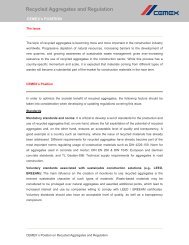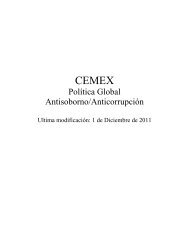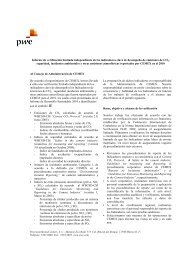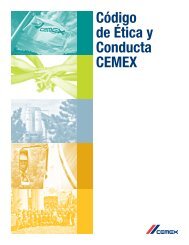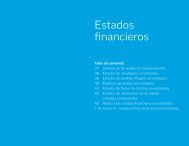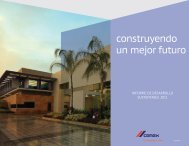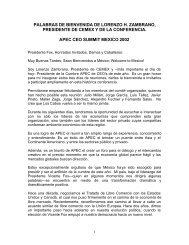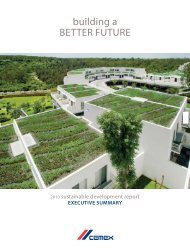building a STRONGER foundation - Cemex
building a STRONGER foundation - Cemex
building a STRONGER foundation - Cemex
You also want an ePaper? Increase the reach of your titles
YUMPU automatically turns print PDFs into web optimized ePapers that Google loves.
CEMEX, S.A.B. DE C.V. AND SUBSIDIARIES<br />
Notes to the Consolidated Financial Statements – (Continued)<br />
As of December 31, 2010, 2009 and 2008<br />
(Millions of Mexican pesos)<br />
G) OTHER INVESTMENTS AND NON-CURRENT RECEIVABLES (note 9B)<br />
Other investments and non-current accounts receivable include CEMEX’s collection rights with respect to investments with maturities of<br />
more than twelve months as of the balance sheet date. Non-current assets resulting from the valuation of derivative financial instruments, as<br />
well as investments in private funds and other investments which are recognized at their estimated fair value as of the balance sheet date, and<br />
their changes in valuation are included in the statements of operations as part of the Comprehensive Financing Result.<br />
Beginning on January 1, 2010, in accordance with MFRS C-3 "Accounts Receivable," long-term accounts receivable are initially recognized at<br />
fair value. Subsequent changes in valuation are recognized in the Comprehensive Financing Result. The adoption of MFRS C-3, as of January<br />
1, 2010, generated a reduction of approximately Ps146 in long-term accounts receivable, an increase in deferred tax assets of approximately<br />
Ps41 and a reduction in retained earnings of approximately Ps105.<br />
H) PROPERTY, MACHINERY AND EQUIPMENT (note 10)<br />
Property, machinery and equipment are recognized at their acquisition or construction cost, as applicable. When inflationary accounting is<br />
applied during high-inflation periods, such assets should be restated using the factors derived from the general price index of the countries<br />
where the assets are held.<br />
Depreciation of fixed assets is recognized within “Cost of sales” and “Administrative and selling expenses,” depending on the utilization of<br />
the respective assets, and is calculated using the straight-line method over the estimated useful lives of the assets, except for mineral reserves,<br />
which are depleted using the units-of-production method. The maximum average useful lives by category of assets are as follows:<br />
Years<br />
Administrative <strong>building</strong>s .................................................................................................................................................... 35<br />
Industrial <strong>building</strong>s............................................................................................................................................................. 34<br />
Machinery and equipment in plant ..................................................................................................................................... 21<br />
Ready-mix trucks and motor vehicles ................................................................................................................................ 8<br />
Office equipment and other assets...................................................................................................................................... 9<br />
During 2010, 2009 and 2008, CEMEX capitalized, as part of the historical cost of fixed assets, the Comprehensive Financing Result, which<br />
includes interest expense, and, when inflationary accounting is applied during periods of high inflation, the monetary position result, arising<br />
from existing debt during the construction or installation period of significant fixed assets, considering CEMEX’s corporate average interest<br />
rate and the average balance of investments in process for the period.<br />
Costs incurred in respect of operating fixed assets that result in future economic benefits, such as an extension in their useful lives, an increase<br />
in their production capacity or in safety, as well as those costs incurred to mitigate or prevent environmental damage, are capitalized as part of<br />
the carrying amount of the related assets. The capitalized costs are depreciated over the remaining useful lives of such fixed assets. Other costs,<br />
including periodic maintenance on fixed assets, are expensed as incurred.<br />
I) BUSINESS COMBINATIONS, GOODWILL, OTHER INTANGIBLE ASSETS AND DEFERRED CHARGES (note 11)<br />
In accordance with MFRS B-7, “Business Combinations,” CEMEX applies the purchase method as the sole recognition alternative through the<br />
allocation of the purchase price to all assets acquired and liabilities assumed based on their estimated fair values as of the acquisition date.<br />
Intangible assets acquired are identified and recognized at fair value. Any unallocated portion of the purchase price is recognized as goodwill,<br />
which is not amortized and is subject to periodic impairment tests (note 2J). If applicable, goodwill is subsequently adjusted for any correction to<br />
the preliminary assessment given to the assets acquired and/or liabilities assumed, within the twelve-month period after purchase.<br />
CEMEX capitalizes intangible assets acquired, as well as costs incurred in the development of intangible assets, when future economic<br />
benefits associated with the assets are identified and there is evidence of control over such benefits. Intangible assets are presented at their<br />
acquisition or development cost, and are restated during high inflation periods to comply with MFRS B-10. Such assets are classified as<br />
having a definite or indefinite life; the latter are not amortized since the period cannot be accurately established in which the benefits<br />
associated with such intangibles will terminate. Amortization of intangible assets of definite life is calculated under the straight-line method.<br />
Direct costs incurred in debt issuances or borrowings are capitalized and amortized as part of the effective interest rate of each transaction<br />
over its maturity. These costs include commissions and professional fees. Direct costs incurred in the development stage of computer software<br />
for internal use are capitalized and amortized through the operating results over the useful life of the software, which on average is<br />
approximately 5 years.<br />
Startup costs are recognized in the income statement as they are incurred. Costs associated with research and development activities<br />
(“R&D”), performed by CEMEX to create new products and services, as well as to develop processes, equipment and methods to optimize<br />
operational efficiency and reduce costs, are recognized in the operating results as incurred. The Technology and Energy departments in<br />
CEMEX undertake all significant R&D activities as part of their daily activities. In 2010, 2009 and 2008, total combined expenses of these<br />
departments were approximately Ps519 (US$41), Ps408 (US$30) and Ps348 (US$31), respectively.<br />
F-11



